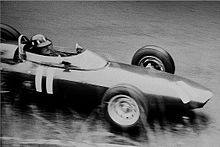
The 1960 Italian Grand Prix was a Formula One motor race held at Monza on 4 September 1960. It was race 9 of 10 in the 1960 World Championship of Drivers and race 8 of 9 in the 1960 International Cup for Formula One Manufacturers. The race was won by American driver Phil Hill driving a Ferrari 246 F1.

The 1962 French Grand Prix was a Formula One motor race held at Rouen-Les-Essarts on 8 July 1962. It was race 4 of 9 in both the 1962 World Championship of Drivers and the 1962 International Cup for Formula One Manufacturers. The race was won by Dan Gurney, his first Formula One victory, driving a Porsche, that company's only win as a constructor in a Formula One championship race coming after three years of racing. It was the third time that the French Grand Prix was held at Rouen, last time being 1957.
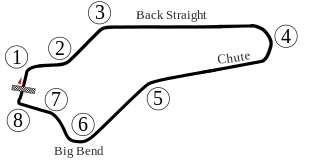
The 1962 United States Grand Prix was a Formula One motor race held on October 7, 1962, at the Watkins Glen Grand Prix Race Course in Watkins Glen, New York. It was race 8 of 9 in both the 1962 World Championship of Drivers and the 1962 International Cup for Formula One Manufacturers. The 100-lap race was won by Lotus driver Jim Clark after starting from pole position. Graham Hill finished second for the BRM team and Cooper driver Bruce McLaren came in third.

The 1963 French Grand Prix was a Formula One motor race held at Reims on 30 June 1963. It was race 4 of 10 in both the 1963 World Championship of Drivers and the 1963 International Cup for Formula One Manufacturers. The race was won by Jim Clark driving a Lotus 25-Climax 1.5 litre V8.

The 1963 United States Grand Prix was a Formula One motor race held on October 6, 1963, at the Watkins Glen Grand Prix Race Course in Watkins Glen, New York. It was race 8 of 10 in both the 1963 World Championship of Drivers and the 1963 International Cup for Formula One Manufacturers. The 110-lap race was won by BRM driver Graham Hill after he started from pole position. His teammate Richie Ginther finished second and Lotus driver Jim Clark came in third.

The 1964 United States Grand Prix was a Formula One motor race held on October 4, 1964, at the Watkins Glen Grand Prix Race Course in Watkins Glen, New York. It was race 9 of 10 in both the 1964 World Championship of Drivers and the 1964 International Cup for Formula One Manufacturers. The 110-lap race was won by BRM driver Graham Hill after he started from fourth position. John Surtees finished second for the Ferrari team and Brabham driver Jo Siffert came in third.

The 1964 Mexican Grand Prix was a Formula One motor race held at the Ciudad Deportiva Magdalena Mixhuca in Mexico City on October 25, 1964. It was race 10 of 10 in both the 1964 World Championship of Drivers and the 1964 International Cup for Formula One Manufacturers.

The 1965 United States Grand Prix was a Formula One motor race held on October 3, 1965, at the Watkins Glen Grand Prix Race Course in Watkins Glen, New York. It was race 9 of 10 in both the 1965 World Championship of Drivers and the 1965 International Cup for Formula One Manufacturers. The 110-lap race was won by BRM driver Graham Hill after he started from pole position. Dan Gurney finished second for the Brabham team and his teammate Jack Brabham came in third.

The 1966 United States Grand Prix was a Formula One motor race held on October 2, 1966, at the Watkins Glen Grand Prix Race Course in Watkins Glen, New York. It was race 8 of 9 in both the 1966 World Championship of Drivers and the 1966 International Cup for Formula One Manufacturers. The race was the ninth United States Grand Prix. It was the sixth to be held at Watkins Glen. The race was held over 108 laps of the 3.78-kilometre circuit for a total race distance of 408 kilometres.

The 1961 Formula One season was the 15th season of Formula One motor racing. It featured the 1961 World Championship of Drivers and the 1961 International Cup for F1 Manufacturers, which were contested concurrently from 14 May to 8 October over an eight race series. The season also included numerous non-championship races for Formula One cars.
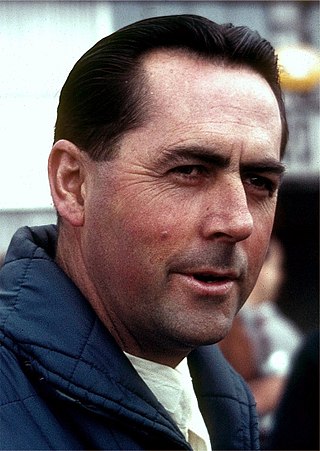
The 1960 Formula One season was the 14th season of the FIA's Formula One motor racing. It featured the 11th FIA World Championship of Drivers, the third International Cup for F1 Manufacturers and numerous non-championship Formula One races. The World Championship commenced on 7 February and ended on 20 November after ten races.
Michael Henderson Spence was a British racing driver from England. He participated in 37 Formula One World Championship Grands Prix, debuting on 8 September 1963. He achieved one podium, and scored a total of 27 championship points. He also participated in numerous non-Championship Formula One races, as well as sports car racing.
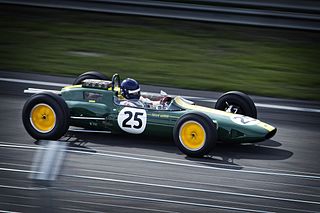
The Lotus 25 was a racing car designed by Colin Chapman for the 1962 Formula One season. It was a revolutionary design, the first fully stressed monocoque chassis to appear in Formula One. In the hands of Jim Clark it took 14 World Championship Grand Prix wins and propelled him to his 1963 World Championship title. Its last World Championship win was at the 1965 French Grand Prix.

The Lotus 33 was a Formula One car designed by Colin Chapman and Len Terry and built by Team Lotus. A development of the successful Lotus 25, in the hands of Jim Clark it won five World Championship Grands Prix in 1965, taking Clark to his second World Championship.

The Brabham BT19 is a Formula One racing car designed by Ron Tauranac for the British Brabham team. The BT19 competed in the 1966 and 1967 Formula One World Championships and was used by Australian driver Jack Brabham to win his third World Championship in 1966. The BT19, which Brabham referred to as his "Old Nail", was the first car bearing its driver's name to win a World Championship race.

The BRM P261, also known as the BRM P61 Mark II, is a Formula One motor racing car, designed and built by the British Racing Motors team in Bourne, Lincolnshire, England. The BRM P261 was introduced for the 1964 Formula One season, and its design was an evolution of Tony Rudd's one-off BRM P61 car of 1963. The P261 had a relatively long racing career; variants of the car were still being entered for Formula One World Championship Grands Prix as late as 1968. During the course of their front-line career BRM P261s won six World Championship races, in the hands of works drivers Graham Hill and Jackie Stewart, and finished second in both the Drivers' and Constructors' Championship standings in 1964 and 1965. Stewart, Hill and Richard Attwood also used works P261s to compete in the Tasman Series in 1966. The BRMs dominated, with Stewart winning four, Hill two, and Attwood one of the 1966 Tasman Series' eight races. Stewart also won the title. The works-backed Reg Parnell Racing team returned in 1967 with Stewart and Attwood, where Stewart added another two wins to his tally. In terms of races won and total Championship points scored, the P261 was the most successful car in BRM's history.
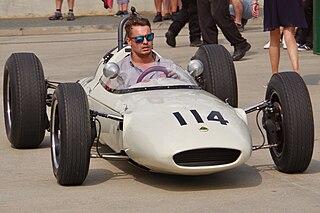
The Lotus 24 was a Formula One racing car designed by Team Lotus for the 1962 Formula One season. Despite some early success in non-Championship Grands Prix, it was eclipsed by the technically superior Lotus 25 and rarely featured in the points in World Championship races.

The Honda RA271 was Honda's second Formula One racing car, and its first to actually enter a race. The chief engineer on the project was Yoshio Nakamura, with Tadashi Kume in charge of engine development. It was driven in three races during 1964 by American driver Ronnie Bucknum.

The Brabham BT3 is a Formula One racing car. It was the first Formula One design to be produced by Motor Racing Developments for the Brabham Racing Organisation, and debuted at the 1962 German Grand Prix. The Brabham BT3 was the vehicle with which team owner – then two-time World Champion – Jack Brabham, became the first driver ever to score World Championship points in a car bearing his own name, at the 1962 United States Grand Prix. The following year Brabham also became the first driver ever to win a Formula One race at the wheel of an eponymous car, again driving the BT3, at the 1963 Solitude Grand Prix. The BT3 design was modified only slightly to form the Tasman Series-specification Brabham BT4 cars.
The BRM P61 was a Formula One racing car built for the 1963 Formula One season. It was BRM's first attempt at the monocoque design introduced by Lotus a year earlier. Fundamental design issues would mean the car only competed 2 Grands Prix before being garaged in favor of the older, more reliable spaceframe P57. A redesigned monocoque car, dubbed the P261, was introduced for 1964.

